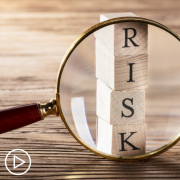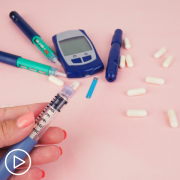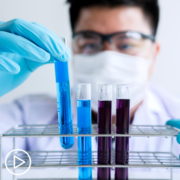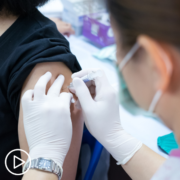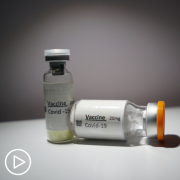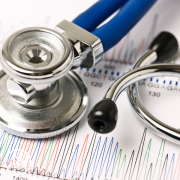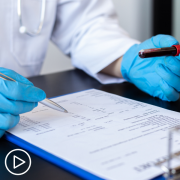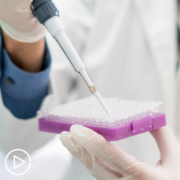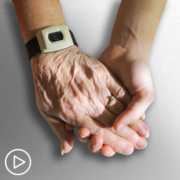Factors to Consider When Choosing an AML Treatment from Patient Empowerment Network on Vimeo.
What test results and factors should be considered when choosing an acute myeloid leukemia (AML) treatment? Expert Dr. Ellen Ritchie explains how test results impact AML prognosis and treatment – and other factors that come into play when determining a treatment approach.
Dr. Ellen K. Ritchie is assistant professor of medicine and a member of the Leukemia Program at the Weill Cornell Medical College of Cornell University and the New York Presbyterian Hospital. More about Dr. Ritchie, here.
See More From INSIST! AML
Related Resources:
Transcript:
Katherine:
How do the results of these tests affect prognosis and treatment?
Dr. Ritchie:
Well, when a patient has AML, if they are a fit patient, if it will help us determine after initial induction, whether to cure the patient we need to do a bone marrow transplant, or we can just continue with chemotherapy.
And those are really important things to determine. So, if you have a good prognosis AML, if you have an AML that has certain translocations like inversion 16 or 821, or if you have a CEPBA mutation or you have an NPM1 mutation, and that’s all you have, you may do particularly well with chemotherapy treatment alone. And you won’t need to have a bone marrow transplant.
If you have certain other mutations, we know that the only way that we’re going to cure you, is with a bone marrow transplant. And if you are fit, when we finish induction and even as we’re doing induction, we’re preparing you for a bone marrow transplant down the line.
One disadvantage, just to mention about the molecular testing, is it doesn’t come back as quickly as some of the other testing. So that you will have already started induction chemotherapy most generally before the mutational testing comes back. Which can be anywhere – depending upon the institution, between seven and 21 days. So, it takes time for those results to be available.
Katherine:
Outside of test results, Dr. Ritchie, what other factors should be considered when choosing treatment?
Dr. Ritchie:
So, you want to choose whether a patient is most likely to benefit from intense induction chemotherapy. With strong chemotherapies where the backbone of those therapies would be an anthracycline, like daunorubicin (Cerubidine) or cytarabine (Liposomal), or daunorubicin or idarubicin (Idamycin PFS), together with cytarabine. And these are intensive chemotherapies. Versus, non-intensive chemotherapy which is able to be done as an outpatient, more frequently. And it is something that is gentler for a patient, they’re less likely to have severe toxicity. And the backbone of those regimens is using a drug called azacitidine (Vidaza) or decitabine (Inqovi), together with a second drug called venetoclax (Venclexta).
So, these are the two backbones, there may be clinical trials or there may be targetable aspects of your leukemia, which drugs would be added to either of those backbones. But those are the two backbones. And I also like to identify those patients that may not benefit from chemotherapy at all. And so, it’s very important, I think to really get to know your patient. And I spend time with my patient, particularly on the first visit, to understand not only their physical health, but their mental health. How good is their cognition, what is their mood, are they depressed, or are they happy people? And what is their circumstance? Do they have people to support them? Do they live close to family? Is a caregiver able to come, with an elderly patient for example, to visits?
Those, and whether or not they’re living alone and need tremendous support. So that’s really important to determine and helps me to choose what the best therapy might be. And also, concurrently what I can do to shore up the patient to do better with whatever therapy that I’m giving them. I.e., if you’re depressed, let’s work on that, or if your blood pressure is too high, or if you are – your diabetes is out of control at the same time that I’m seeing you, to try and fix those particular problems. In older patients I often do sort of a miniature version of the geriatric assessment. And in trials that have been so far, the most important aspects of the geriatric assessment, are really what is your cognitive function? Do have a mild dementia, or do you not have a mild dementia? Because dementia may be or mild dementia may be associated with poorer outcome.
The other is, are you able to do what we call the incidental tasks of daily life. So, you know fundamental tasks are really brushing your teeth and combing your hair, and dressing yourself. But are you able to do your cooking and your shopping and your banking and those things? Patients who have trouble doing their cooking and shopping and banking, and those types of activities, that also has been associated with a poor overall survival in AML. So, it’s really important to determine all of those aspects and if there are any deficiencies, to really know that the only therapeutic choice for that particular patient would be a low-intensity therapy.







